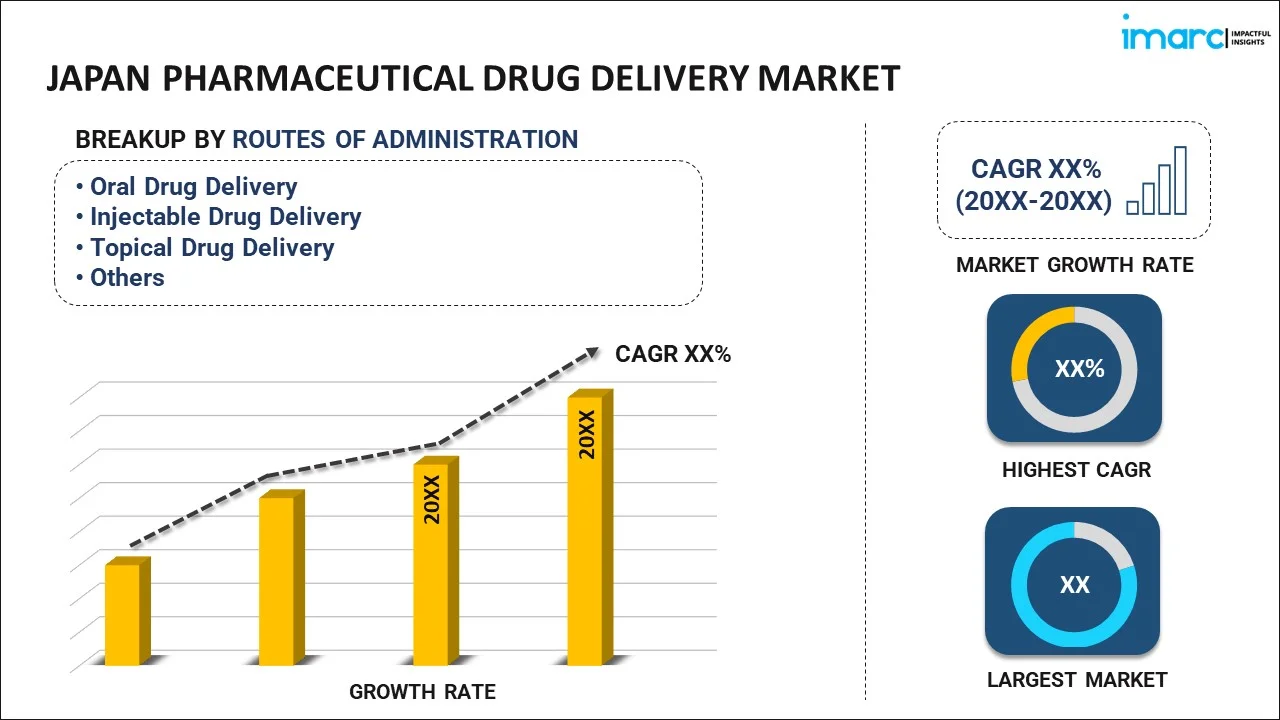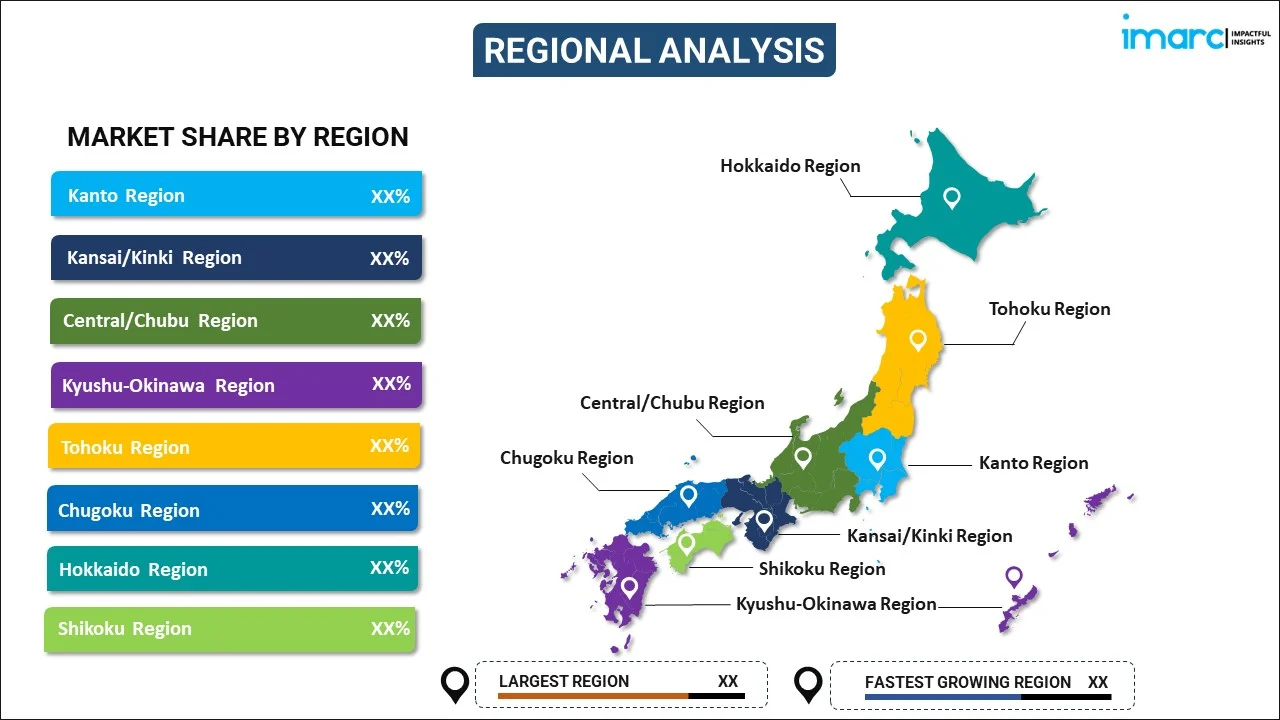
Japan Pharmaceutical Drug Delivery Market Report by Route of Administration (Oral Drug Delivery, Injectable Drug Delivery, Topical Drug Delivery, Ocular Drug Delivery, Pulmonary Drug Delivery, Implantable Drug Delivery, Transmucosal Drug Delivery, Nasal Drug Delivery), Application (Infectious Diseases, Cancer, Cardiovascular Diseases, Diabetes, Respiratory Diseases, Central Nervous System Disorders, Autoimmune Diseases, and Others), End User (Hospitals, Ambulatory Surgery Centers, Home Care Settings, Diagnostic Centers, and Others), and Region 2025-2033
Market Overview:
Japan pharmaceutical drug delivery market size reached USD 66.4 Billion in 2024. Looking forward, IMARC Group expects the market to reach USD 101.1 Billion by 2033, exhibiting a growth rate (CAGR) of 4.43% during 2025-2033. The rising emphasis of leading players on personalized medicine fostering drug delivery innovations and numerous advancements in nanotechnology are primarily driving the market growth.
|
Report Attribute
|
Key Statistics
|
|---|---|
|
Base Year
|
2024 |
|
Forecast Years
|
2025-2033
|
|
Historical Years
|
2019-2024
|
| Market Size in 2024 | USD 66.4 Billion |
| Market Forecast in 2033 | USD 101.1 Billion |
| Market Growth Rate (2025-2033) | 4.43% |
Pharmaceutical drug delivery is the systematic and controlled administration of medicines to patients with the goal of optimizing the therapeutic results. This involves the utilization of various methods and technologies to ensure precise dosage, improved absorption by the body, and the targeted delivery of pharmaceutical compounds to specific locations within the body. The field of drug delivery is focused on improving the effectiveness, safety, and convenience of treatments while minimizing potential side effects. It encompasses a wide array of approaches, including oral, injectable, transdermal, inhalation, and implantable methods. Currently, pharmaceutical drug delivery is gaining significant traction in reshaping patient care on a global scale by maximizing the advantages of medications and facilitating more personalized and efficient therapeutic solutions.
Japan Pharmaceutical Drug Delivery Market Trends:
The pharmaceutical drug delivery market in Japan is experiencing significant growth driven by several compelling factors. Notably, the rising emphasis on personalized medicine and targeted therapies is a key driver, aligning treatment approaches more closely with individual patient needs. Continuous advancements in drug formulation and delivery technologies are also playing a pivotal role in catalyzing market expansion. Researchers in Japan are consistently exploring innovative strategies, including nanotechnology, liposomes, and microparticles, to enhance drug stability, bioavailability, and controlled release. These innovations enable the development of novel drug delivery systems capable of addressing challenges associated with traditional formulations, such as poor solubility, rapid metabolism, or short half-life, thus driving market growth. Moreover, the increasing prevalence of chronic diseases like diabetes, cardiovascular disorders, and cancer is fueling the demand for advanced drug delivery systems in Japan. These conditions often require long-term treatment involving multiple medications, and optimized drug delivery methods can significantly improve therapeutic outcomes and enhance the quality of life for patients. Factors such as rapid urbanization, ongoing enhancements in the healthcare sector, and extensive research and development (R&D) efforts by industry leaders are also contributing positively to the pharmaceutical drug delivery market in Japan. Collectively, these elements are expected to shape a favorable outlook for market growth in the country over the forecasted period.
Japan Pharmaceutical Drug Delivery Market Segmentation:
IMARC Group provides an analysis of the key trends in each segment of the market, along with forecasts at the country level for 2025-2033. Our report has categorized the market based on route of administration, application, and end user.
Route of Administration Insights:

- Oral Drug Delivery
- Injectable Drug Delivery
- Topical Drug Delivery
- Ocular Drug Delivery
- Pulmonary Drug Delivery
- Implantable Drug Delivery
- Transmucosal Drug Delivery
- Nasal Drug Delivery
The report has provided a detailed breakup and analysis of the market based on the route of administration. This includes oral drug delivery, injectable drug delivery, topical drug delivery, ocular drug delivery, pulmonary drug delivery, implantable drug delivery, transmucosal drug delivery, and nasal drug delivery.
Application Insights:
- Infectious Diseases
- Cancer
- Cardiovascular Diseases
- Diabetes
- Respiratory Diseases
- Central Nervous System Disorders
- Autoimmune Diseases
- Others
A detailed breakup and analysis of the market based on the application have also been provided in the report. This includes infectious diseases, cancer, cardiovascular diseases, diabetes, respiratory diseases, central nervous system disorders, autoimmune diseases, and others.
End User Insights:
- Hospitals
- Ambulatory Surgery Centers
- Home Care Settings
- Diagnostic Centers
- Others
The report has provided a detailed breakup and analysis of the market based on the end user. This includes hospitals, ambulatory surgery centers, home care settings, diagnostic centers, and others.
Regional Insights:

- Kanto Region
- Kansai/Kinki Region
- Central/ Chubu Region
- Kyushu-Okinawa Region
- Tohoku Region
- Chugoku Region
- Hokkaido Region
- Shikoku Region
The report has also provided a comprehensive analysis of all the major regional markets, which include Kanto Region, Kansai/Kinki Region, Central/ Chubu Region, Kyushu-Okinawa Region, Tohoku Region, Chugoku Region, Hokkaido Region, and Shikoku Region.
Competitive Landscape:
The market research report has also provided a comprehensive analysis of the competitive landscape. Competitive analysis such as market structure, key player positioning, top winning strategies, competitive dashboard, and company evaluation quadrant has been covered in the report. Also, detailed profiles of all major companies have been provided.
Japan Pharmaceutical Drug Delivery Market Report Coverage:
| Report Features | Details |
|---|---|
| Base Year of the Analysis | 2024 |
| Historical Period | 2019-2024 |
| Forecast Period | 2025-2033 |
| Units | Billion USD |
| Scope of the Report | Exploration of Historical Trends and Market Outlook, Industry Catalysts and Challenges, Segment-Wise Historical and Future Market Assessment:
|
| Routes of Administration Covered | Oral Drug Delivery, Injectable Drug Delivery, Topical Drug Delivery, Ocular Drug Delivery, Pulmonary Drug Delivery, Implantable Drug Delivery, Transmucosal Drug Delivery, Nasal Drug Delivery |
| Applications Covered | Infectious Diseases, Cancer, Cardiovascular Diseases, Diabetes, Respiratory Diseases, Central Nervous System Disorders, Autoimmune Diseases, Others |
| End Users Covered | Hospitals, Ambulatory Surgery Centers, Home Care Settings, Diagnostic Centers, Others |
| Regions Covered | Kanto Region, Kansai/Kinki Region, Central/ Chubu Region, Kyushu-Okinawa Region, Tohoku Region, Chugoku Region, Hokkaido Region, Shikoku Region |
| Customization Scope | 10% Free Customization |
| Post-Sale Analyst Support | 10-12 Weeks |
| Delivery Format | PDF and Excel through Email (We can also provide the editable version of the report in PPT/Word format on special request) |
Key Questions Answered in This Report:
- How has the Japan pharmaceutical drug delivery market performed so far and how will it perform in the coming years?
- What has been the impact of COVID-19 on the Japan pharmaceutical drug delivery market?
- What is the breakup of the Japan pharmaceutical drug delivery market on the basis of route of administration?
- What is the breakup of the Japan pharmaceutical drug delivery market on the basis of application?
- What is the breakup of the Japan pharmaceutical drug delivery market on the basis of end user?
- What are the various stages in the value chain of the Japan pharmaceutical drug delivery market?
- What are the key driving factors and challenges in the Japan pharmaceutical drug delivery?
- What is the structure of the Japan pharmaceutical drug delivery market and who are the key players?
- What is the degree of competition in the Japan pharmaceutical drug delivery market?
Key Benefits for Stakeholders:
- IMARC’s industry report offers a comprehensive quantitative analysis of various market segments, historical and current market trends, market forecasts, and dynamics of the Japan pharmaceutical drug delivery market from 2019-2033.
- The research report provides the latest information on the market drivers, challenges, and opportunities in the Japan pharmaceutical drug delivery market.
- Porter's five forces analysis assist stakeholders in assessing the impact of new entrants, competitive rivalry, supplier power, buyer power, and the threat of substitution. It helps stakeholders to analyze the level of competition within the Japan pharmaceutical drug delivery industry and its attractiveness.
- Competitive landscape allows stakeholders to understand their competitive environment and provides an insight into the current positions of key players in the market.
Need more help?
- Speak to our experienced analysts for insights on the current market scenarios.
- Include additional segments and countries to customize the report as per your requirement.
- Gain an unparalleled competitive advantage in your domain by understanding how to utilize the report and positively impacting your operations and revenue.
- For further assistance, please connect with our analysts.
 Inquire Before Buying
Inquire Before Buying
 Speak to an Analyst
Speak to an Analyst
 Request Brochure
Request Brochure
 Request Customization
Request Customization




.webp)




.webp)












